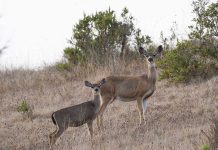Ceremonies this morning mark addition of 3,600 acres to county
park system
Bouquets of wild flowers bursting throughout the new Coyote Lake-Harvey Bear Ranch County Park give spring-time color to South Valley’s soon-to-open natural wonderland. Set along the verdant pastoral hills southeast of Morgan Hill, Santa Clara County’s newest recreational playground will hold its grand opening this morning.
Workers this week have been busy putting the finishing touches on the brand-new county park. They’ve been placing signs along trails winding through the gently sloping terrain along the Diablo Range.
“It’s a great piece of land,” said Don Rocha, the county’s parks natural resource program supervisor who helped oversee development of the project’s $1.3 million first phase.
The park’s trail system is unique because it was specially designed to preserve the natural setting and did not incorporate ranching or logging roads as other county parks have.
“These trails system gave us an opportunity to start with a clean slate,” Rocha said. More than 14 miles of environmentally friendly nature trails have been finished throughout Bear Ranch Park for the enjoyment of hikers, equestrian riders and mountain bikers, he said.
“After this, there’s an additional 20 miles of trail to build,” he said of the development’s second phase.
The new park adds more than 3,600 acres of prime pastoral terrain to the 916-acre Coyote Lake County Park. Combined, this gives South Valley the second largest county park in Santa Clara County after Grant Ranch Park on Mt. Hamilton east of San Jose.
Nature lovers can find more than 200 species of wild flowers throughout Bear Ranch Park’s terrain that includes flat-terrain meadows and hilly oak-covered woodlands, said Senior County Park Ranger Chris Crockett. Trees include madrone, elderberry and buckeye. Golden eagles and burrowing owls make their home in the park.
“These are special status species,” Crockett said.
From a human settlement point of view, the park has a rich and colorful history, he said. The Spanish explorer Juan Bautista de Anza passed through the park in 1776 while surveying what is now Coyote Creek.
During a tour Monday morning, Crockett pointed to a row of trees at the Bear Ranch entrance and described how renown South Valley settler Martin Murphy Sr., built a home at that location more than 150 years ago. Murphy purchased the land for $1,500 after leading the first wagon train pioneers over the Sierra mountains to California in 1846.
About 4.5 miles of trail along the park’s hill-top ridges have been incorporated into the Bay Area Ridge Trail, said Lisa Killough, Santa Clara County Parks Department director.
“It’s a spectacular piece of the Ridge Trail,” Killough said of Bear Ranch’s link to the proposed 500-mile project that will one day circle the San Francisco Bay Area. “You get some great vistas looking at Coyote Lake and the Gilroy-San Martin area.”
This fall, with the addition of a park in Marin County, the project will have connected about 300 miles of ridge trail.
The park’s first phase began in October 2004 as workers prepared new trails as well as constructing parking and restroom facilities at the Bear Ranch and Mendoza Ranch entrances.
The second phase will develop an off-leash area for dogs, and more horse and bike trails as well as an environmental education center at the Bear Ranch entrance.
The third phase, which will most likely start construction more than a decade from now, will include an 18-hole golf course and club house on land near the Bear Ranch entrance.
The county spent $11.6 million in 1997 to purchase the 2,968-acre Bear Ranch property from the children of Harvey Bear, a former Morgan Hill cattle rancher. And an additional $2.5 million in funding purchased the adjacent 711 acres of Mendoza Ranch from Russell and Carolyn Mendoza, now Lassen County residents.
Funding to develop the park came from Santa Clara County’s Park Charter Fund as well as a $200,000 grant from the California Coastal Conservancy and a $200,000 from the Santa Clara Valley Water District’s grant for its Trails, Parks and Open Space Grant program.
Correspondent Martin Cheek can be reached at ed******@*************es.com








